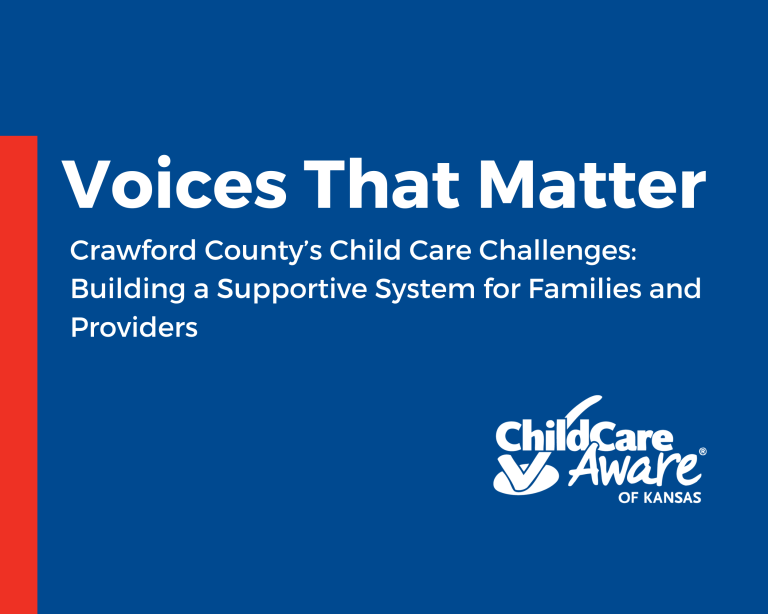A Growing Community with High Child Care Needs
In Crawford County, Kansas, providers, families, and coalitions are working together to make the child care system work for all members of its community. With more than 35,000 inhabitants and seated in Southeastern Kansas, this is a county that has a high need for affordable, readily available, and quality child care.
According to Kari, a coalition leader in the county, and Mikayla, a mother with three children who attend daily child care, the availability of infant spots, particularly, is a critical need. Additionally, Kari shared, the recruitment and retention of providers is an area for improvement, and as reported by Kay, a 30-plus-year child care veteran provider, providers need funding for continuing education.
The impact of these pressing issues in Crawford County is readily apparent. For parents like Mikayla, whose daughter had to wait for child care for multiple years and whose two infant sons had been waitlisted for 6 months, finding child care that met her desires for quality and affordability was like “running in circles.” On the other side of the waitlist coin, Kay shared that she has had a long waitlist for infants, and that parents with whom she works echo Mikayla’s frustrations.
Kari shared that recruiting and retaining new providers has been a continual struggle, and Kay attributes much of that struggle to a need for provider funding.
Without enough funding, providers are not only not adequately compensated for their work, but they are also denied the opportunity for continuing education in their field that keeps them up-to-date on high-quality practices.
This makes providers, especially in-home providers, feel “left behind,” Kay expressed.
Potential Solutions: Empowering the Community Through Education and Funding
The question that must be asked, then, is what kind of solutions can agencies like Child Care Aware of Kansas and many others offer to counties like Crawford? For Kari, who has already received grant funding from CCAKS, funding is just one piece of the puzzle. She shared that education leads to empowerment, and that offering CDA (Child Development Associates) courses and certifications to high schoolers and young adults looking to enter the child care field would help close the gap in provider availability.
This would, in turn, increase the amount of available infant slots, something that Mikayla and so many others desperately need. Kay shared that an increase in grant funding and subsidization to make training and professional development for providers free would also make providers feel supported and would encourage them to continue in their field.
Looking Forward: Overcoming Challenges with Community Support
As Crawford County looks toward the future, there is a road paved with challenges, but this county is one that does not shy away from hard work and dedication to its inhabitants.
It is community members like Kari, Mikayla, and Kay who make up the heart of Southeastern Kansas’ child care system, and their needs are echoed throughout the state. Funding, continuing education, and the ready availability of infant care in Crawford County are all pressing issues that, while not insurmountable, will take a great deal of support from outside of this immediate community in order to overcome these challenges.
-

Casadie Smith
Casadie Smith, Director, StoryComm Solutions
Casadie Smith received her Master of Arts in Communication & Storytelling Studies from East Tennessee State University in 2023, where she focused on qualitative research and applied storytelling. Her years of varied experiences as a writer, creative, early childhood educator, curious mind, and much more have offered her unique insight into the importance of connecting people of all backgrounds through stories. Casadie currently works as a professional freelance storyteller, writer, researcher, and educator, and you can find more information about her services at https://www.casadiesmith.com.







